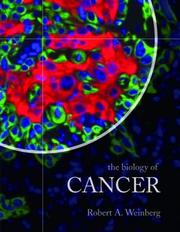| Listing 1 - 10 of 11 | << page >> |
Sort by
|
Periodical
Abstract | Keywords | Export | Availability | Bookmark
 Loading...
Loading...Choose an application
- Reference Manager
- EndNote
- RefWorks (Direct export to RefWorks)
Cancer genes --- Cancer --- Cancer genes. --- Genes, Neoplasm --- Research --- Research. --- Neoplasm Genes --- Cancer Genes --- Cancer Gene --- Gene, Cancer --- Gene, Neoplasm --- Genes, Cancer --- Neoplasm Gene --- Genes --- Genetic aspects --- Oncology

ISBN: 0815340788 0815340761 9780815340782 9780815340768 Year: 2007 Publisher: New York, N.Y. Garland Science
Abstract | Keywords | Export | Availability | Bookmark
 Loading...
Loading...Choose an application
- Reference Manager
- EndNote
- RefWorks (Direct export to RefWorks)
The Biology of Cancer is a textbook for students studying the molecular and cellular bases of cancer at the undergraduate, graduate, and medical school levels. The principles of cancer biology are presented in an organized, cogent, and in-depth manner. The clarity of writing, supported by an extensive full-color art program and numerous pedagogical features, makes the book accessible and engaging. The information unfolds through the presentation of key experiments that give readers a sense of discovery and provide insights into the conceptual foundation underlying modern cancer biology.
Molecular biology --- Oncology. Neoplasms --- moleculaire biologie --- kwaadaardige gezwellen --- Cancer --- Cancer cells. --- Cellules cancéreuses --- Molecular aspects. --- Genetic aspects. --- Aspect moléculaire --- Aspect génétique --- Cancer cells --- Neoplasms --- Genes, Neoplasm --- Cell Transformation, Neoplastic --- Molecular aspects --- Genetic aspects --- genetics --- Cell Transformation, Neoplastic. --- Genes, Neoplasm. --- genetics. --- Genetics. --- Cellules cancéreuses --- Aspect moléculaire --- Aspect génétique --- Monograph --- Cancer - Molecular aspects --- Cancer - Genetic aspects --- Neoplasms - genetics
Book
ISBN: 9780815342199 9780815342205 9780815345282 0815342195 0815345283 0815342209 Year: 2014 Publisher: New York, N.Y. Garland Science
Abstract | Keywords | Export | Availability | Bookmark
 Loading...
Loading...Choose an application
- Reference Manager
- EndNote
- RefWorks (Direct export to RefWorks)
Cancer --- Cancer cells --- Molecular aspects --- Genetic aspects --- Cancer cells. --- Cellules cancéreuses --- Aspect moléculaire --- Cell Transformation, Neoplastic --- Genes, Neoplasm --- Cellules cancéreuses --- Aspect moléculaire --- moleculaire biologie --- Molecular biology --- kwaadaardige gezwellen --- Oncology. Neoplasms --- Neoplasms --- genetics --- Molecular aspects. --- Genetic aspects. --- Aspect génétique --- Cancer - Molecular aspects --- Cancer - Genetic aspects --- Neoplasms - genetics

ISBN: 9781588294258 1588294250 9781592598939 9786610359288 1280359285 1592598935 Year: 2005 Publisher: Totowa, N.J. : Humana Press,
Abstract | Keywords | Export | Availability | Bookmark
 Loading...
Loading...Choose an application
- Reference Manager
- EndNote
- RefWorks (Direct export to RefWorks)
Bioinformatic integration of the findings from recent genomic and proteomic research has made possible the development of highly selective therapeutics that can target specific cellular pathways controlling cell proliferation, differentiation, metastasis, evasion of immune surveillance, angiogenesis, and apoptosis. In The Oncogenomics Handbook, a panel of internationally recognized researchers and clinicians provides an integrated overview of cancer drug discovery and development from the bench to the clinic, showing with broad strokes and representative examples the drug development process as a network of linked components leading from the discovered target to the ultimate therapeutic product. Following that path, the authors explain genomic databases and how to discover oncological targets from them, how then to advance from the gene and transcript to the level of protein biochemistry, how next to move from the chemical realm to that of the living cell and, ultimately, pursue animal modeling and clinical development. Emerging cancer therapeutics including rituximab, Herceptin®, Avastin™, ABGX-EGF, Velcade®, Iressa®, and Zevalin® are addressed. Additional chapters review clinical diagnostics, bioanalytics, and biomarkers and their importance to therapeutic outcome; detail antiangiogenic, supportive, immunomodulatory, and tumor-targeted approaches to cancer therapy; and provide a systems biology-bioinformatics overview of strategies and initiatives for the postgenomic era. Highlights include cancer genomics, transcriptomics, gene expression analysis, proteomic and enzymatic cancer profiling technologies, and cellular and animal approaches to cancer target validation. Authoritative and state-of-the-art, The Oncogenomics Handbook offers cancer researchers and drug developers a comprehensive update on the contribution of the genomic revolution to cancer drug discovery and development.
Cancer --- Oncogenes --- Genomics --- Proteomics --- Oncogènes --- Génomique --- Protéomique --- Genetic aspects --- Handbooks, manuals, etc. --- Aspect génétique --- Guides, manuels, etc. --- Cancer -- Genetic aspects -- Handbooks, manuals, etc. --- Genomics -- Handbooks, manuals, etc. --- Oncogenes -- Handbooks, manuals, etc. --- Proteomics -- Handbooks, manuals, etc. --- Genes, Neoplasm --- Diseases --- Biology --- Computational Biology --- Genes --- Biological Science Disciplines --- Genome Components --- Natural Science Disciplines --- Disciplines and Occupations --- Genome --- Genetic Structures --- Genetic Phenomena --- Phenomena and Processes --- Genetics --- Neoplasms --- Medicine --- Health & Biological Sciences --- Oncology --- Genome research --- Genomes --- Onc genes --- Cancers --- Carcinoma --- Malignancy (Cancer) --- Malignant tumors --- Research --- Medicine. --- Oncology. --- Medicine & Public Health. --- Tumors --- Clinical sciences --- Medical profession --- Human biology --- Life sciences --- Medical sciences --- Pathology --- Physicians --- Molecular biology --- Proteins --- Molecular genetics --- Cancer genes --- Proto-oncogenes --- Oncology .
Book
ISBN: 1441982302 1441982310 Year: 2010 Publisher: Austin, Tex. : New York, New York : Landes Bioscience ; Springer Science+Business Media,
Abstract | Keywords | Export | Availability | Bookmark
 Loading...
Loading...Choose an application
- Reference Manager
- EndNote
- RefWorks (Direct export to RefWorks)
Our understanding of human cancer in the past 40 years has been driven by linking innovative concepts and cutting edge technologies to key problems identified by clinical research. Some of the successes in cancer genetics identified from clinical work have been the identification of specific gene deletions in human chromosomes, the use of PCR-based cloning methodologies to identify and clone human cancer genes, the validation of the human cancer genes using transgenetic technologies in the mouse, and the ability to sequence whole genomes that has recently allowed a collation of all somatic and germline mutations in a human genome. In the same generation, entirely different disciplines involved in basic life science research have used model organisms like yeast, flies, worms, and cancer causing animal viruses as tools to develop windows to see into the machinery of the cell life cycle. The discoveries of pro-apoptotic genes, oncogenes, and covalent control mechanisms like phosphorylation and ubiquitination using the tools of science and technology have all been awarded Nobel prizes for their contribution to our understanding of how cells work. The discovery of p53 using the tumor causing animal virus SV40 falls into this pioneering period of biological and medical research.
Cell Transformation, Neoplastic -- genetics. --- Genes, p53. --- p53 antioncogene. --- p53 protein. --- p53 antioncogene --- p53 protein --- Neoplastic Processes --- Biology --- Genes, Tumor Suppressor --- Biological Science Disciplines --- Genes, Neoplasm --- Pathologic Processes --- Genes, Recessive --- Neoplasms --- Natural Science Disciplines --- Pathological Conditions, Signs and Symptoms --- Genes --- Diseases --- Genome Components --- Disciplines and Occupations --- Genome --- Genetic Structures --- Genetic Phenomena --- Phenomena and Processes --- Genetics --- Genes, p53 --- Cell Transformation, Neoplastic --- Medicine --- Health & Biological Sciences --- Oncology --- Protein p53 --- Protein TP53 --- TP53 protein --- p53 gene --- p53 suppressor gene --- Medicine. --- Cancer research. --- Biomedicine. --- Cancer Research. --- Cancer research --- Clinical sciences --- Medical profession --- Human biology --- Life sciences --- Medical sciences --- Pathology --- Physicians --- DNA-binding proteins --- Phosphoproteins --- Tumor suppressor proteins --- Antioncogenes --- Oncology. --- Tumors
Book
ISBN: 1617793574 9786613447685 1283447681 1617793582 Year: 2012 Publisher: New York : Humana Press,
Abstract | Keywords | Export | Availability | Bookmark
 Loading...
Loading...Choose an application
- Reference Manager
- EndNote
- RefWorks (Direct export to RefWorks)
Gene expression studies have revealed diagnostic profiles and upregulation of specific pathways in many solid tumors. The explosion of new information in gene expression profiling could potentially lead to the development of tailored treatments in many solid tumors. In addition many studies are ongoing to validate these signatures also in predicting response to hormonal, chemotherapeutic and targeted agents in breast cancer as well as in other tumors. Diagnostic, Prognostic and Therapeutic Value of Gene Signatures provides readers a useful and comprehensive resource about the range of applications of microarray technology in oncological diseases. Topics covered include gene signatures and soft tissue sarcomas, prognostic relevance of breast cancer signatures, gene expression profiling of colorectal cancer and liver metastasis, gene signatures in GISTs, CNVs and gene expression profiles in pancreatic cancer, and gene signatures in head/neck, lung and gastric tumors. Diagnostic, Prognostic and Therapeutic Value of Gene Signatures will be of great value to residents and fellows, physicians, pathologists and medical oncologists.
Cancer -- Genetic aspects. --- Cancer genes. --- Gene expression. --- Gene expression --- Cancer genes --- Cancer --- Genetic Techniques --- Biology --- Genes --- Biological Science Disciplines --- Genome Components --- Investigative Techniques --- Natural Science Disciplines --- Analytical, Diagnostic and Therapeutic Techniques and Equipment --- Genome --- Genetic Structures --- Disciplines and Occupations --- Genetic Phenomena --- Phenomena and Processes --- Genetics --- Genes, Neoplasm --- Gene Expression Profiling --- Medicine --- Health & Biological Sciences --- Pathology --- Oncology --- Genetic aspects --- Gene therapy. --- Therapy, Gene --- Expression --- Medicine. --- Laboratory medicine. --- Oncology. --- Pathology. --- Medicine & Public Health. --- Laboratory Medicine. --- Genetic engineering --- Therapeutics --- Genetic regulation --- Oncology . --- Medical laboratories. --- Diagnosis, Laboratory --- Health facilities --- Laboratories --- Tumors --- Disease (Pathology) --- Medical sciences --- Diseases --- Medicine, Preventive --- Clinical medicine --- Clinical pathology --- Diagnostic laboratory tests --- Laboratory diagnosis --- Laboratory medicine --- Medical laboratory diagnosis --- Diagnosis
Book
ISBN: 1461436842 148999663X 1461436850 1283944804 Year: 2013 Publisher: New York : Springer,
Abstract | Keywords | Export | Availability | Bookmark
 Loading...
Loading...Choose an application
- Reference Manager
- EndNote
- RefWorks (Direct export to RefWorks)
The primary cause of death related to cancers can be traced back to metastases, originated from cancer cells. The presence of metastatic disease, the spread of cancer cells, is the most important prognostic and survival factor in patients with cancer. Although treatment of the primary tumor is well established and usually results in local control, treating metastatic disease is a much more daunting task. At diagnosis, few patients present with clinically detectable metastatic lesions regardless of the clinical prognostic factor. Clinical trials assessing potential therapeutic agents are important in order to define the best specific treatment for a particular patient, which are the basis for patient-oriented research that eventually lead to personalized medicine. This volume aims to comprehensively present the latest research and information about metastasis. Understanding the mechanisms underlying the metastatic phenomenon could have vast implications for the large number of patients who are at a high risk for the development of metastasis.
Bone metastasis. --- Cancer. --- Neoplasms. --- Metastasis --- Genes, Neoplasm --- Neoplastic Processes --- Neoplasms --- Genes --- Genome Components --- Diseases --- Genome --- Genetic Structures --- Genetic Phenomena --- Phenomena and Processes --- Neoplasm Metastasis --- Genes, Tumor Suppressor --- Medicine --- Health & Biological Sciences --- Oncology --- Metastasis. --- Research. --- Cancer --- Cancer metastasis --- Dissemination of cancer --- Metastases --- Metastatic cancer --- Neoplasm metastasis --- Spread of cancer --- Tumor dissemination --- Tumor metastasis --- Tumor spread --- Dissemination --- Medicine. --- Cancer research. --- Pharmacology. --- Biomedicine. --- Cancer Research. --- Pharmacology/Toxicology. --- Pathology --- Cancer invasiveness --- Cancer of unknown primary origin --- Oncology. --- Toxicology. --- Chemicals --- Pharmacology --- Poisoning --- Poisons --- Tumors --- Toxicology --- Drug effects --- Medical pharmacology --- Medical sciences --- Chemotherapy --- Drugs --- Pharmacy --- Cancer research --- Physiological effect

ISBN: 1588291065 9786610842810 1280842814 1592594085 Year: 2003 Volume: 234 Publisher: Totowa, NJ : Humana Press : Imprint: Humana,
Abstract | Keywords | Export | Availability | Bookmark
 Loading...
Loading...Choose an application
- Reference Manager
- EndNote
- RefWorks (Direct export to RefWorks)
Since the discovery of p53 as a tumor suppressor, numerous methods have evolved to reveal its unique structural features and biochemical functions. In p53 Protocols, Sumitra and Swati Palit Deb have assembled an indispensable collection of novel techniques that have proven most useful for studying the physiological properties of p53 both in vitro and in vivo. Described by leading basic and clinical researchers who have successfully used the methods, the techniques provide proven solutions to problems in studying the purification, target identification, gene expression, quantitation, interaction, signaling, transactivation, and transrepression of p53. The methods are also useful for delineating the functions of other proteins that may act as tumor or growth suppressors. Each technique includes step-by-step instructions, troubleshooting notes, a theoretical review, and discussion of associated problems that might arise during the course of investigation. Special effort has been made to discuss problems and their solutions to help ease the learning curve when standardizing a new method. Diverse and highly practical, p53 Protocols offers both beginning and experienced researchers in cancer biology a gold-standard compendium of readily reproducible techniques for studying p53 and related proteins.
Protein p53 --- Tumor Suppressor Proteins --- Genes, p53 --- Neoplasms --- p53 protein --- p53 antioncogene --- Protéine p53 --- Gène p53 --- analysis --- therapeutic use --- physiology --- genetics --- Laboratory manuals --- Manuels de laboratoire --- Electronic books. -- local. --- p53 antioncogene -- Laboratory manuals. --- p53 protein -- Laboratory manuals. --- Tumor Suppressor Protein p53 --- Genetics --- Physiology --- Biological Science Disciplines --- Phosphoproteins --- DNA-Binding Proteins --- Biology --- Genes, Tumor Suppressor --- Nuclear Proteins --- Neoplasm Proteins --- Diseases --- Proteins --- Genes, Recessive --- Natural Science Disciplines --- Genes, Neoplasm --- Disciplines and Occupations --- Amino Acids, Peptides, and Proteins --- Genes --- Chemicals and Drugs --- Genome Components --- Genome --- Genetic Structures --- Genetic Phenomena --- Phenomena and Processes --- Animal Biochemistry --- Cytology --- Human Anatomy & Physiology --- Health & Biological Sciences --- Protéine p53 --- Gène p53 --- p53 gene --- p53 suppressor gene --- Antioncogenes --- Protein TP53 --- TP53 protein --- DNA-binding proteins --- Tumor suppressor proteins --- analysis. --- physiology. --- genetics. --- Cytology. --- Cell Biology. --- Cell biology --- Cellular biology --- Cells --- Cytologists

ISBN: 0387095802 9786612970986 1282970984 0387095810 1489981438 Year: 2011 Publisher: New York : Springer,
Abstract | Keywords | Export | Availability | Bookmark
 Loading...
Loading...Choose an application
- Reference Manager
- EndNote
- RefWorks (Direct export to RefWorks)
Retroviruses cause chronic infections and insertion mutations in their hosts, often leading to the appearance of tumors. Studies of retrovirus-induced tumors have led to our understanding of many crucial concepts in cell and cancer biology, including the discoveries of reverse transcriptase, viral oncogenes, cellular proto-oncogenes and signal transduction pathways. This monograph provides an intriguing set of chapters on the many facets of retroviral involvement in cancers arising in a variety of organisms from fish to humans. Each chapter is written by experts in the field and relates recent work to previous experimental data. Retroviruses use many different mechanisms to induce cancers, ranging from activation of microRNAs, inactivation of tumor suppressor genes, activation or modifications of proto-oncogenes, as well as expression of viral proteins that manipulate cell signaling and the immune system. In recent years, retroviruses have been used as tools, not only for the characterization of cellular pathways, but also as vectors to deliver therapeutic or engineered genes. This knowledge is all the more startling due to the revelation that nearly 10% of the human genome consists of endogenous retroviruses, including many that are transcriptionally active. The emergence of new endogenous retroviruses causing lethal leukemias in koalas and, potentially, prostate cancer in humans ensures that the unique interactions of these viruses with their hosts will continue to fascinate and illuminate us.
Carcinogenesis. --- Foreign workers --Germany (West). --- German language --Social aspects. --- German language --Syntax --Study and teaching --Foreign speakers. --- Grammar, Comparative and general. --- Language and languages --Variation. --- Retrovirus infections. --- Viral carcinogenesis. --- Retroviruses --- Oncogenic viruses --- Viral carcinogenesis --- RNA Viruses --- Vertebrate Viruses --- Genes --- Diseases --- Viruses --- Genome Components --- Genome --- Organisms --- Genetic Structures --- Genetic Phenomena --- Phenomena and Processes --- Retroviridae --- Oncogenic Viruses --- Genes, Neoplasm --- Neoplasms --- Biology --- Medicine --- Health & Biological Sciences --- Microbiology & Immunology --- Oncology --- Language and languages --- Grammar, Comparative and general --- German language --- Foreign workers --- Languages & Literatures --- Philology & Linguistics --- Variation --- Study and teaching --- Syntax --- Foreign speakers --- Social aspects --- Retroviruses. --- Oncogenic viruses. --- C-type RNA viruses --- Leukemogenic viruses --- Leukoviruses --- Oncornaviruses --- Oncoviruses --- RNA tumor viruses --- Cancer-causing viruses --- Cancer viruses --- Oncoviruses (Oncogenic viruses) --- Tumor viruses --- Tumorigenic viruses --- Medicine. --- Cancer research. --- Medical microbiology. --- Virology. --- Biomedicine. --- Cancer Research. --- Medical Microbiology. --- RNA viruses --- Microbial carcinogenesis --- Oncology. --- Medical virology. --- Microbiology. --- Medical microbiology --- Virology --- Virus diseases --- Tumors --- Microbial biology --- Microorganisms --- Microbiology --- Cancer research
Book
ISBN: 1441911448 1461424518 1441911456 Year: 2009 Publisher: New York, N.Y. : Austin, Tex. : Springer Science+Business Media ; Landes Bioscience,
Abstract | Keywords | Export | Availability | Bookmark
 Loading...
Loading...Choose an application
- Reference Manager
- EndNote
- RefWorks (Direct export to RefWorks)
The initial identification of the Adenomatous polyposis coli (Apc) gene as the site of mutations in familial adenomatous polyposis (FA P) was described in 1992. A causal relationship between Apc mutations and intestinal tract tumours was confirmed three years later with the establishment of the Min mouse model. These mice are heterozygous for Apc and develop numerous intestinal tumours that mimic FA P. Subsequently, Apc has emerged as the most commonly mutated gene in colorectal cancer with reports varying between 50-80 per cent of sporadic tumours carrying such mutations. The search for how m
Adenomatous Polyposis Coli Protein. --- Adenomatous Polyposis Coli. --- Colon (Anatomy) -- Cancer. --- Colorectal Neoplasms -- Metabolism. --- Genes, APC. --- Tumor suppressor proteins. --- Colon (Anatomy) --- Tumor suppressor proteins --- Adenomatous Polyposis Coli --- Colorectal Neoplasms --- Genes, APC --- Metabolism --- Adenomatous Polyposis Coli Protein --- Intestinal Polyposis --- Intestinal Neoplasms --- Colonic Neoplasms --- Neoplastic Syndromes, Hereditary --- Colonic Diseases --- Metabolic Phenomena --- Cytoskeletal Proteins --- Genes, Tumor Suppressor --- Tumor Suppressor Proteins --- Rectal Diseases --- Adenomatous Polyps --- Proteins --- Neoplasm Proteins --- Intestinal Diseases --- Neoplasms --- Genes, Neoplasm --- Phenomena and Processes --- Gastrointestinal Neoplasms --- Genes, Recessive --- Adenoma --- Genetic Diseases, Inborn --- Gastrointestinal Diseases --- Digestive System Neoplasms --- Genes --- Diseases --- Neoplasms, Glandular and Epithelial --- Congenital, Hereditary, and Neonatal Diseases and Abnormalities --- Amino Acids, Peptides, and Proteins --- Chemicals and Drugs --- Digestive System Diseases --- Genome Components --- Neoplasms by Site --- Neoplasms by Histologic Type --- Genome --- Genetic Structures --- Genetic Phenomena --- Oncology --- Medicine --- Health & Biological Sciences --- Cancer --- Cancer. --- Antioncoproteins --- Growth suppressor proteins --- Metastasis suppressor proteins --- Colon cancer --- Colorectal cancer --- Medicine. --- Biomedicine. --- Biomedicine general. --- Clinical sciences --- Medical profession --- Human biology --- Life sciences --- Medical sciences --- Pathology --- Physicians --- Antioncogenes --- Health Workforce --- Biomedicine, general.
| Listing 1 - 10 of 11 | << page >> |
Sort by
|

 Search
Search Feedback
Feedback About UniCat
About UniCat  Help
Help News
News